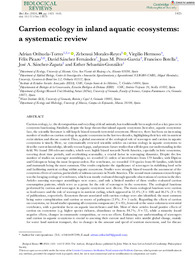Please use this identifier to cite or link to this item:
https://hdl.handle.net/11000/33952Carrion ecology in inland aquatic ecosystems: a systematic review
| Title: Carrion ecology in inland aquatic ecosystems: a systematic review |
| Authors: Orihuela Torres, Adrian Antonio Morales-Reyes, Zebensui Hermoso, Virgilio Picazo, Félix Sánchez Fernandez, David Pérez-García, Juan M. Botella, Francisco Sanchez-Zapata, Jose Antonio Sebastian-Gonzalez, Esther |
| Editor: Wiley |
| Department: Departamentos de la UMH::Biología Aplicada |
| Issue Date: 2024-03-20 |
| URI: https://hdl.handle.net/11000/33952 |
| Abstract: Carrion ecology, i.e. the decomposition and recycling of dead animals, has traditionally been neglected as a key process in ecosystem functioning. Similarly, despite the large threats that inland aquatic ecosystems (hereafter, aquatic ecosystems) face, the scientific literature is still largely biased towards terrestrial ecosystems. However, there has been an increasing number of studies on carrion ecology in aquatic ecosystems in the last two decades, highlighting their key role in nutrient recirculation and disease control. Thus, a global assessment of the ecological role of scavengers and carrion in aquatic ecosystems is timely. Here, we systematically reviewed scientific articles on carrion ecology in aquatic ecosystems to describe current knowledge, identify research gaps, and promote future studies that will deepen our understanding in this field. We found 206 relevant studies, which were highly biased towards North America, especially in lotic ecosystems, covering short time periods, and overlooking seasonality, a crucial factor in scavenging dynamics. Despite the low number of studies on scavenger assemblages, we recorded 55 orders of invertebrates from 179 families, with Diptera and Coleoptera being the most frequent orders. For vertebrates, we recorded 114 species from 40 families, with birds and mammals being the most common. Our results emphasise the significance of scavengers in stabilising food webs and facilitating nutrient cycling within aquatic ecosystems. Studies were strongly biased towards the assessment of the ecosystem effects of carrion, particularly of salmon carcasses in North America. The second most common research topic was the foraging ecology of vertebrates, which was mostly evaluated through sporadic observations of carrion in the diet. Articles assessing scavenger assemblages were scarce, and only a limited number of these studies evaluated carrion consumption patterns, which serve as a proxy for the role of scavengers in the ecosystem. The ecological functions performed by carrion and scavengers in aquatic ecosystems were diverse. The main ecological functions were carrion as food source and the role of scavengers in nutrient cycling, which appeared in 52.4% (N = 108) and 46.1% (N = 95) of publications, respectively. Ecosystem threats associated with carrion ecology were also identified, the most common being water eutrophication and carrion as source of pathogens (2.4%; N = 5 each). Regarding the effects of carrion on ecosystems, we found studies spanning all ecosystem components (N = 85), from soil or the water column to terrestrial vertebrates, with a particular focus on aquatic invertebrates and fish. Most of these articles found positive effects of carrion on ecosystems (e.g. higher species richness, abundance or fitness; 84.7%; N = 72), while a minority found negative effects, changes in community composition, or even no effects. Enhancing our understanding of scavengers and carrion in aquatic ecosystems is crucial to assessing their current and future roles amidst global change, mainly for water–land nutrient transport, due to changes in the amount and speed of nutrient movement, and for disease control and impact mitigation, due to the predicted increase in occurrence and magnitude of mortality events in aquatic ecosystems. |
| Keywords/Subjects: aquatic subsidy carcass freshwater land–water interface ecological process |
| Knowledge area: CDU: Ciencias puras y naturales: Biología |
| Type of document: info:eu-repo/semantics/article |
| Access rights: info:eu-repo/semantics/openAccess |
| DOI: https://doi.org/10.1111/brv.13075 |
| Published in: Biological Reviews, Volume99, Issue 4, 2024, Pages 1425-1443 |
| Appears in Collections: Artículos Biología Aplicada |
.png)

